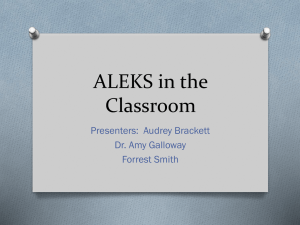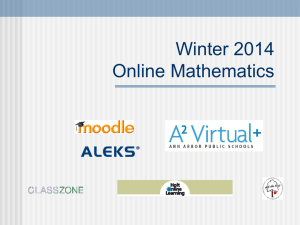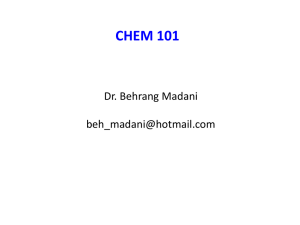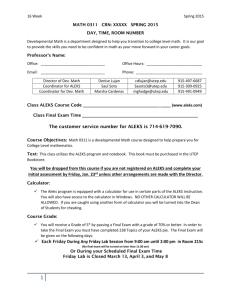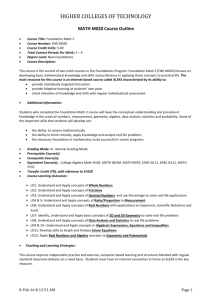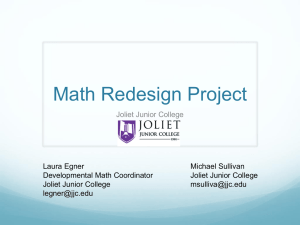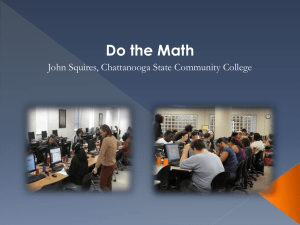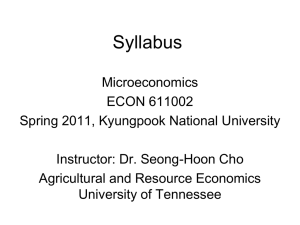Redesign of Beginning and Intermediate Algebra
advertisement
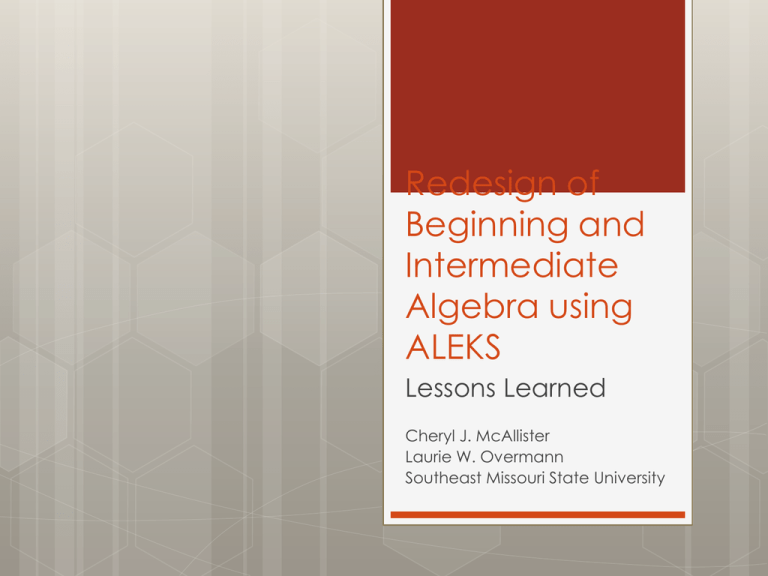
Redesign of Beginning and Intermediate Algebra using ALEKS Lessons Learned Cheryl J. McAllister Laurie W. Overmann Southeast Missouri State University Plan Develop a technology based developmental algebra course to improve student success rates not only in this new algebra course but also in future courses requiring algebra. Things to address with the new courses The wide ability levels and backgrounds of students taking the courses. In the traditional lecture model, instructors directed instruction to the ‘middle’ of this range of student backgrounds. There were wide inconsistencies in how the course was taught, assessed, and administered. The responsibility for learning was dominated by the instructor. There was minimal one-on-one interaction during class time with individual students. Do Two classrooms were converted to computer labs specifically for using the mathematics learning software ALEKS. Two new courses were developed which used ALEKS software as the primary content delivery system (MA101: Beginning Algebra, MA102: Intermediate Algebra) to replace the traditional lectures courses (MA090 and MA095). More than 5000 students have taken MA101/102 since Fall 2009. The Department of Mathematics faculty and graduate assistants are involved in teaching these courses. Provide extensive training to faculty and assistants prior to each semester. Timeline of major and minor changes to the program Fall 2009 – original redesign initiated by Mathematics Department 2008 Review Committee MA090/MA095 traditional courses replaces with MA101/102 technology supported courses Piloted in the spring of 2009 by volunteer faculty. Full implementation in Fall of 2009. Faculty training prior to each spring and fall semester initiated (still happening). Fall 2009 - continued Students worked at their own pace on ALEKS software in a computer lab with one faculty member and two graduate teaching assistants per 35 students. No lectures, all information imparted via the software or as one-on-one tutoring by teaching staff. Final credit/fail grade was based on the number of objectives ‘mastered’ by the student as determined by the ALEKS software assessment program. 70% mastery was considered passing. This was based on the student’s number after a single comprehensive assessment given during finals week. No attendance policy. Courses changed from ‘no credit towards a degree’ to credit bearing general electives. Fall 2010 – changes made to original design These changed were made as a response to data collection and student evaluations and input from other constituents. Midterm progress reports developed and sent to academic advisors. A second chance final exam was initiated, since the final exam was the only assessment used to determine the grade for the students. Formula sheets with notes on the back were allowed during assessments. Staffing changed to one faculty member and three graduate teaching assistants per 70 students. Experienced graduate students were allowed to supervise one of the 35 station labs, while the faculty member staffed, with the less experienced graduate teaching assistant, the other 35 station lab. Spring 2011 Attendance policy approved and implemented based on student success compared to time logged into the ALEKS program. Students who miss the equivalent of one week of class are given a warning by instructor. Students who miss the equivalent of two weeks of class are turned into the department chair for possible withdrawal from the course. Time on Task Essential After ALEKS data had been gathered and analyzed, one important factor in student success was number of hours spent on ALEKS to master the needed skills. One way of accomplishing this was to make sure that students attend class and work on ALEKS. Therefore, an attendance policy was implemented in Spring 2011. The following table compares average number of hours spent by students and their success rate. Initial Assessment Final Assessment Objectives Completed Hours Spent Success Rate Number of Students Fall 2010 12.19 46.31 34.12 43.32 60.06% 1232 Spring 2011 15.48 59.37 43.88 53.7 77.00% 891 Fall 2011 13.78 54.30 40.52 47.25 76.00% 798 An attendance policy is one of the most ‘effective practices’ that has helped in significantly improving the success rate. Summer 2011 – Overmann and McAllister work on a second redesign and structuring the courses. Created UNITS with deadline dates within the ALEKS software to help students evaluate their progress through the material and eliminate the tendency to skip hard material such as word problems and graphing. Paper and pencil quizzes created to develop and evaluate students’ ability to organize their mathematical processes. Graded by the instructor and partial credit given to off-set credit/no credit grading of the final exam. Notebooks to organize the work of students became a mandatory part of the course. Final exam is created to replace ALEKS comprehensive assessment. Final exam aligns with quizzes. Fall 2011 – Pilot of second redesign Based on attendance at NCAT conferences, data collection, experience and concerns from students and administration. Overmann and McAllister pilot the course using the new redesign. Students in these classes are graded in the following manner: 10 Quizzes over units – 10% of grade Notebooks collected twice and graded based on a rubric – 10% of grade Final exam created by the redesign team and administered by ALEKS – 80% of grade. Second chance final still provided for students. Spring 2012 – Full implementation of second redesign Training for all instructors and graduate assistants who would be teaching the courses in the spring semester. Staffing changed to one faculty member and two graduate teaching assistants per 70 students. Fall 2012 Changes include midterm grade in final grade for the course, made to encourage students to improve their approach to the material throughout the semester. New course grade breakdown: 10 Quizzes over units – 10% of grade. Notebooks collected twice and graded based on a rubric – 10% of grade. Midterm exam created by the redesign team and administered by ALEKS – 10% of grade. Final exam created by the redesign team and administered by ALEKS – 70% of grade. Second chance final still provided for students. Identifying ‘at risk’ students While analyzing the data to compare the success rates of students who have taken MA101 with that of MA090, an important finding which came up was that the success rate of students was dependent on their Math ACT scores. The following table gives probability of success in MA101 and MA090 with varying ACT scores. Math ACT scores 15 Probability of Success in MA101 0.4809 Probability of Success in MA090 0.5145 16 0.5149 0.5831 17 0.5487 0.6487 In fall 2012, the Department of Mathematics started a new course – MA050 (Basic Math Skills) for students coming with a Math ACT subscore of 14 and below. This new course also has the same attendance policy as MA101/102. The students coming from this course to MA101 should be well prepared, thus increasing the success and retention rate for future math courses. Spring 2012 Only change was to make the MA102 final grade a letter grade instead of a CR/F course to encourage students to do more than the ‘minimum’ necessary to pass the course. This was based on feedback from College Algebra instructors’ feelings that MA102 students were not prepared for that course. Fall 2013 – more changes It was determined based on data and students’ comments and evaluations of the course that having one exam worth 80% of the student’s grade (midterm and final exams) with no partial credit was not the best way to evaluate student learning of the material. Students wanted their work on the ALEKS program to count towards their final grade. New assessment and grading procedures put into place and will be evaluated at the end of the current semester. Fall 2013 - continued Design team made the following changes: 8 Quizzes over units – 10% of grade. Notebooks collected twice and graded based on a rubric – 10% of grade. Number of ALEKS objectives completed – 10% of grade. Two ‘Unit’ exams created to replace two of the Quizzes. Exams will have both an online and a pencil and paper component – 20% of grade. Midterm exam revised to include an online and pencil and paper component – 20% of grade. Final exam administered by ALEKS – 30% of grade. Second chance final is eliminated. Students no longer allowed to use a ‘notes’ page during exams and quizzes. Check Data about student performance and attitudes was obtained from ALEKS and analyzed. Institutional Research provided data that were used to identify factors responsible for student success. Students, academic advisors, math faculty, and Learning Assistance Programs staff provided feedback. Lessons learned Students don’t do optional. An attendance policy is essential for students in a developmental course. Software fundamentally changes the way we interact with students (good and bad). Software gives you information about student habits, progress, and abilities that we never could have gathered using the traditional model. Software democratizes learning – can’t charm a computer.
